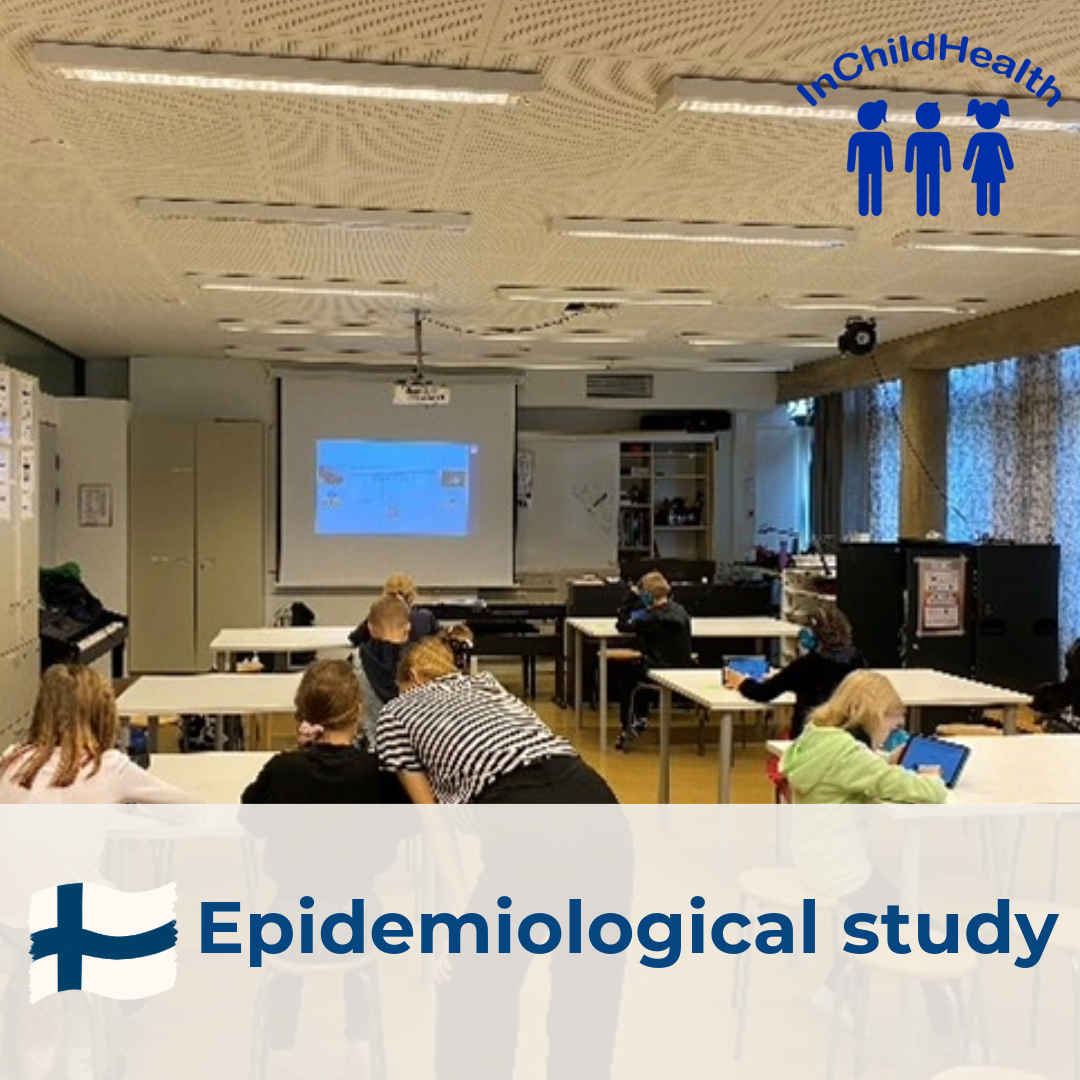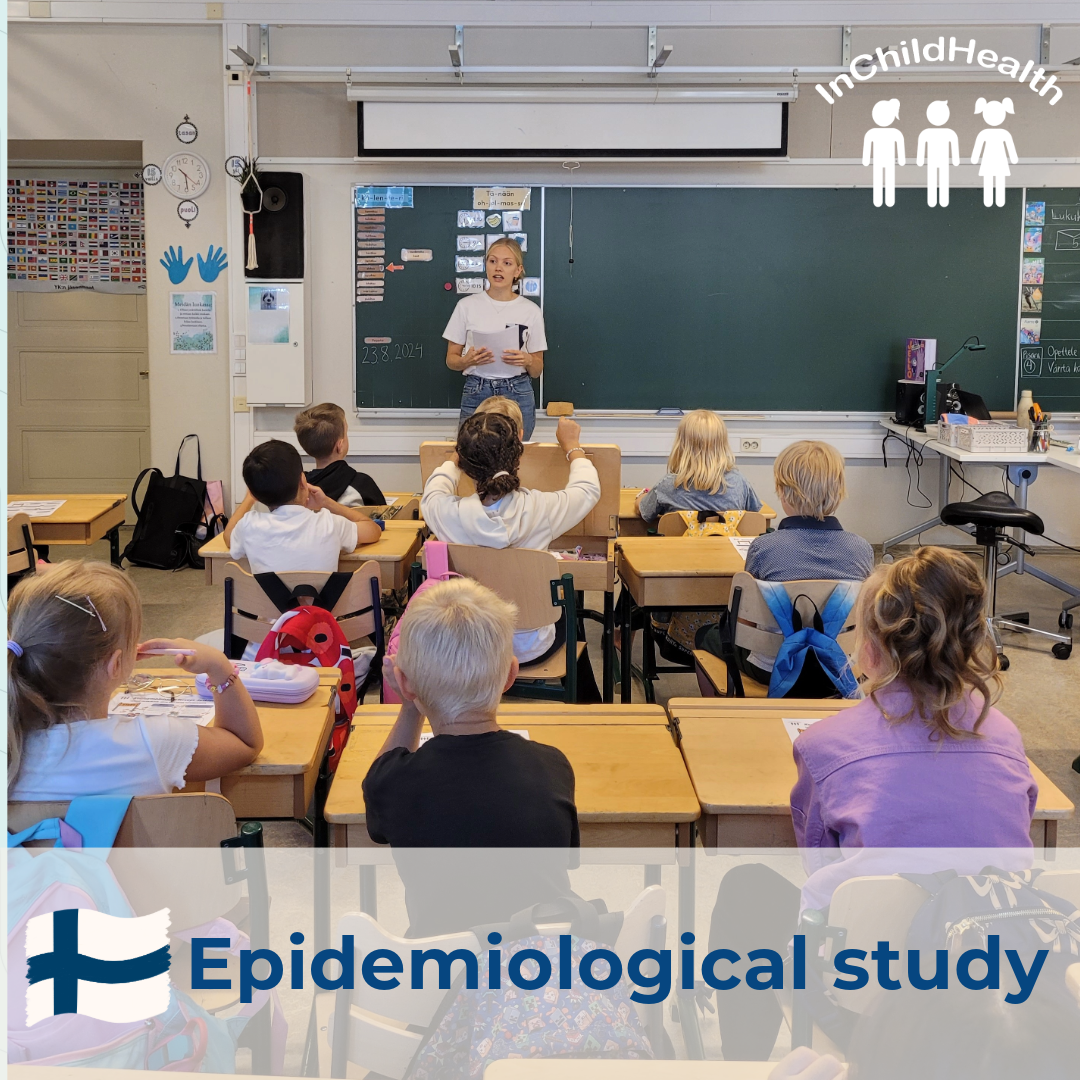Epidemiological Study
Epidemiological study on School environment and health
Children spend up to 90% of their time indoors, making Indoor Air Quality (IAQ) an important determinant of human health. This is especially significant for children whose developing body is particularly vulnerable. School-age children are most exposed to indoor air in school and at home.
The InChildHealth project conducts an epidemiological study to investigate the health effects of school indoor air quality focusing on respiratory infections, symptoms, asthma, allergies, and neurological and cognitive outcomes in school children in three European cities, Helsinki, Barcelona and Copenhagen.
Study population
A 10-month prospective cohort study of school children is conducted between 08/2024 and 06/2025, involving ten schools in each of the three cities.
Altogether 2500-4500 children aged 6-13 years from each city are invited to participate in the cohort study. The study protocols of each city have been approved by the local ethics committees. Consent forms are distributed for children’s parents or caregivers to agree to participate in the epidemiological study. The information collected about the participants is processed and reported in such a way that the participants cannot be identified. European Union and national legislation are followed in all activities related to the collection, processing, and storage of research material. Only named members of the research team have access to the data. Processing and storage of the data takes place in the local servers secured by firewalls, usernames, and passwords.
Indoor air quality (IAQ) assessment at schools
Information is collected on the biological, chemical, and physical conditions affecting the IAQ of the classrooms. The monitored parameters are particulate matter (PM1, PM2.5, PM4, PM10), nitrogen dioxide (NO2), sulphur dioxide (SO2), carbon monoxide (CO), carbon dioxide (CO2), Volatile organic compounds (VOCs), ammonia (NH3), hydrogen sulphide (H2S), methane (CH4), ozone (O3), and microbial contamination (fungi, bacteria and viruses) in addition to temperature (T) and relative humidity (RH).
Parallel with the IAQ measurements, the above-mentioned parameters are also measured in outdoor air. We use a comprehensive sampling approach and analyses correlated with real-time monitoring (to evaluate contaminant level over time) and apply state-of-the-art non-target screening techniques to identify other emerging pollutants. This approach allows us to assess the contribution of emission sources and determine the impact of IAQ interventions and their timing.
In addition, we assess airborne food allergens in classrooms and canteens by collecting settled dust samples once during the study period.
Health information assessment
Children’s health information is collected using parent-administered questionnaires and cognitive tests. All the questionnaires are conducted using the web application REDCap (Research Electronic Data Capture), which is a versatile and secure tool for building and managing online surveys and databases of research.
Background questionnaires
In the beginning of the study, questionnaires will be used to collect information on the child’s background, health, lifestyle, and environmental exposures at home, as well as the impact of the study (citizen science).
Respiratory Health
A short weekly questionnaire is filled out by the caregivers on the occurrence of respiratory infections, and respiratory, eye and skin symptoms. In addition, by linking to official medical registries, we retrieve information on respiratory infections requiring a medical visit, as well as medical visits for asthma.
Asthma control test for children with asthma
Level of asthma control in children with asthma is assessed applying a standardized the Childhood Asthma Control Test (C-ACT), which is filled out monthly by the participants and caregivers.
Neuropsychological assesment
Children complete a battery of standardized and validated cognitive tests in the classroom to assess working memory, attentional function, processing speed, and ability to inhibit cognitive interference. Specifically, working memory is evaluated through the N-back test, attention function through the Flanker test and processing speed and ability to inhibit cognitive interference through the Stroop test. These validated tests are administered through the web-based GORILLA platform.
More information
Epidemiological study in Helsinki
Professor Jouni Jaakkola, University of Oulu (WP3 leader)
Senior Researcher Aino Rantala, University of Oulu (Leader of the Task 3.1. “Epidemiological studies on the environment and health”)
Epidemiological study in Barcelona
Research Professor Xavier Basagaña, ISGlobal
Epidemiological study in Copenhagen
Professor Katrin Vorkamp, Aarhus University
Senior Scientist Patrik Fauser, Aarhus University
News

23.5.2025
Helsinki: ”Research walk” (walkthrough survey) continued in five schools in week 19 / ”Tutkimuskävelyt” (walkthrough survey) jatkuivat viidessä koulussa viikolla 19

27.1.2025
Helsinki: ”Research walk” (walkthrough survey) in schools / ”Tutkimuskävely” (walkthrough survey) kouluissa

8.11.2024
Helsinki: Children’s cognitive tests have started in Helsinki research schools / Lasten kognitiiviset testit ovat alkaneet Helsingin tutkimuskouluissa

14.10.2024
InChildHealth epidemiological study pages

4.9.2024
Helsinki: Recruitment of research participants is open / Tutkimuksen rekrytointi on käynnissä

